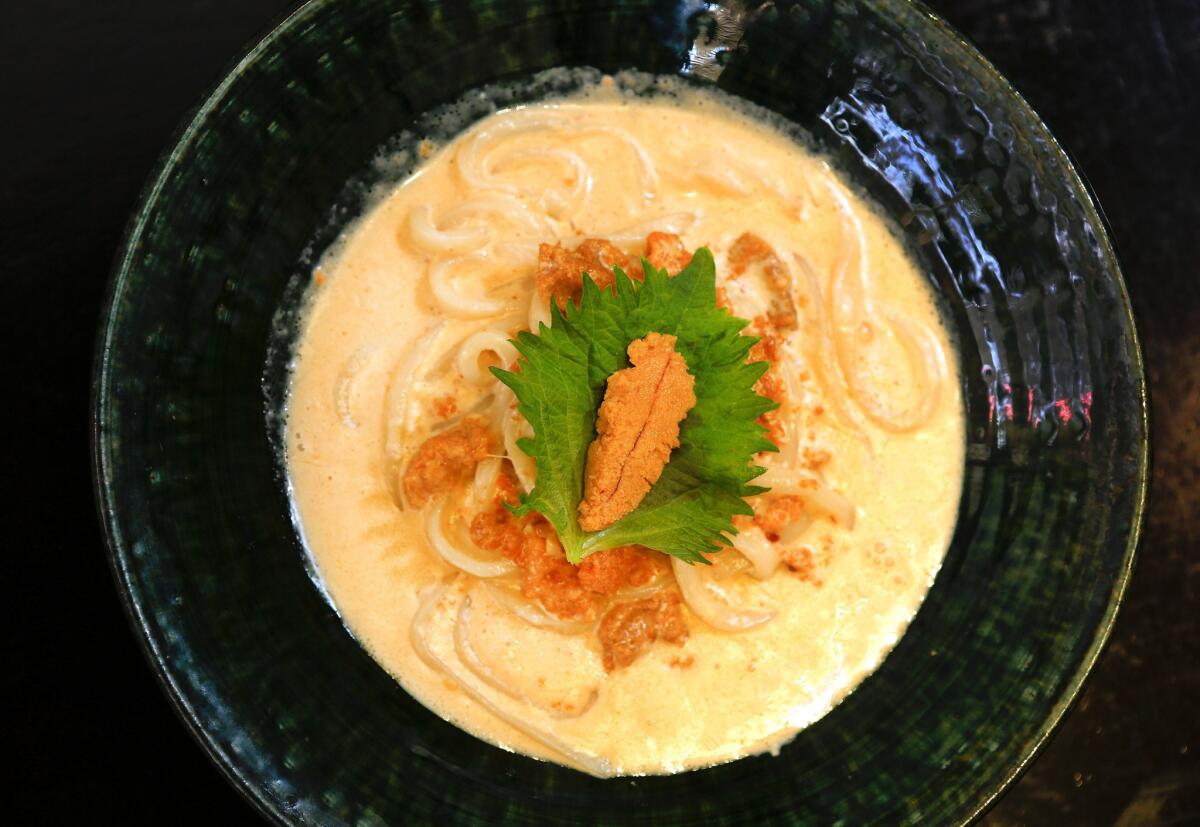Jonathan Gold | L.A. restaurant review: Marugame Monzo is all about udon

There is the line at Marugame Monzo, curling into the somewhat longer line outside the ramen shop Daikokuya a few feet away. There is cold Asahi on tap and a stunningly good appetizer of tempura-fried chicken skin. The raw, sliced Hokkaido scallops with tiny flying fish roe are delicious. The grilled chicken breast with buttery grated ginger is among the better chicken dishes in Little Tokyo.
But you have come to see udon being made in the glass-enclosed kitchen, throw-pillows of dough flattened into disks the size of deep-dish pizza, rolled out into sheets by a man wielding a long dowel, then stretched, folded, rolled out, folded, stretched, dusted with flour, rolled out, then whomped into thick noodles with a hinged knife you canât believe hasnât relieved the cook of his fingertips by now.
The knife, which resembles the blade of a paper cutter, seems to incorporate a ratchet of sorts that scoots it across the dough in precise intervals. The noodles are made to order. The balletic dance of dough continues without pause.
Ramen is the hedonistâs Japanese noodle, designed for sensation, often at its best when it is delivering extreme wallops of garlic, chile or boiled-pork umami. Soba, gingerly fashioned from buckwheat, is the aestheteâs noodle, best when it is most austere. Udon, the traditional noodle of the Kagawa prefecture â Marugame is a town in the area â lies somewhere in the middle, not quite a party noodle (it is hard to imagine an udon equivalent of the Impact 2 ramen at Orochon), but not quite plain.
âTampopo,â the most famous movie about ramen, has strong themes of sex and death. âUdon,â the second-best Japanese noodle movie ever made, is a screwball comedy.
Monzoâs udon are even in their rectangular profile, dense but not grainy, elastic more in terms of flexile strength than in actual stretchiness. If you twined enough of these udon around itself, you could probably hang a modest suspension bridge from them, but you would still be able to bite through the noodles in a single go. The noodles taste like wheat, salt and clean water. They also taste of the liquid in which they are immersed after boiling, but not too much. The hot udon are supple; the cold udon like iron strings. I imagine the noodle maker is fulfilled in his work.
Served hot, ideally as kake udon, sprinkled with crunchy droplets of fried tempura batter that float on the dashi-based broth, the noodles soften and become a bit jollier. You could add fried tofu (called kitsune, or fox, because fox spirits are said to enjoy it), or fried chicken, or slices of rare duck breast, which donât do much for the udon but are tasty enough as additions.
An extra buck or two will get you good-enough tempura to dip in your bowl; the usual pumpkin, eggplant and fish cake, but also baby octopus, nori seaweed and soft-boiled onsen eggs whose oozing yolk thickens the broth. The tempura-fried pickled ginger, bubbling and scarlet, is so delicious I canât believe I havenât seen it before â the sensation is a bit like an onion ring that mysteriously refreshes your appetite instead of killing it. And there is kakiage, a battered ball of onions and vegetables, that is the Bloominâ Onion of the tempura world, which is to say it can sap your will to live.
The foodie excitement about Marugame Monzo is mostly about the modern varieties of udon, which to me kind of miss the point: Most of them may be done better by crossover specialists, like Spoon House in Gardena. The curry udon comes in a thick goo that is pretty close to what you find on your cutlet in Japanese curry houses, and the udon carbonara, as well as the udon gratin, are drenched in thick, cheesy cream. The idea of udon tossed in a sea urchin cream sauce is good, but the actual dish is several notches less coherent than what you would expect to find at a first-rate Italian restaurant â thick, stiff udon tends not to lean into the seafood the way that linguine might. Even the udon in a buttery sauce of cod roe and tender squid, which I like a lot, would be better with Italian pasta than with Monzoâs undeniably superior noodles.
But like a fine violin, the udon is merely a vehicle for the purpose to which it is put â not even a Stradivarius can make a Miley Cyrus ballad sound musical. When served as austere zaru udon, cold, with a dipping sauce of soy, broth and grated radish, Monzoâs noodles taste most strongly of themselves, especially if, as is the custom, you wet just the bottom few inches. The udon is also served cold as bukkake udon â do not look this up on the Internet. You moisten the noodles with a drizzle of chilled broth, but the flavor comes mostly from the sharpness of the garnishes, probably pickled plum with shiso leaf and a sac of seasoned roe.
Marugame Monzo
The udon noodle elevated to cult status.
LOCATION
329 E. 1st St., Little Tokyo, (213) 346-9762
PRICES
Appetizers, $4.25-$15.95; udon, $6.95-$15.95
DETAILS
Open 11:30 a.m. to 2:30 p.m. and 5 to 10 p.m. daily. Credit cards accepted. Beer and sake. Street parking only.
RECOMMENDED DISHES
Fried chicken skin, grilled chicken with ginger sauce, scallop carpaccio, kake udon, zaru udon, plum shiso bukkake udon, cod roe butter squid udon.
More to Read
Eat your way across L.A.
Get our weekly Tasting Notes newsletter for reviews, news and more.
You may occasionally receive promotional content from the Los Angeles Times.











